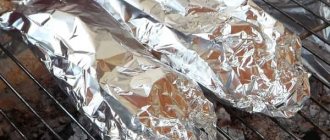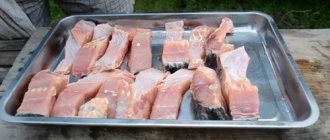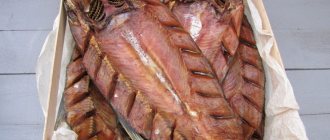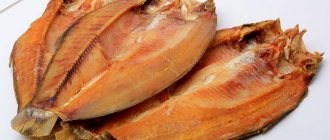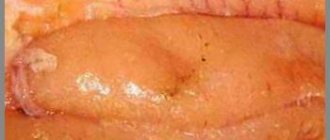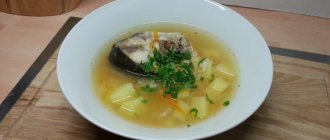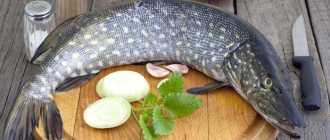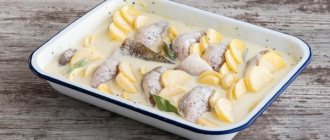Bream is one of the most coveted trophies for freshwater fishermen. This representative of the carp family has excellent taste, and when salted or dried, it is an integral attribute of every gathering.
In order to pickle bream at home, you don’t have to be a culinary “guru” - you just need to have an idea of all the intricacies of the old salting recipe. By the way, this recipe is suitable for salting not only bream, but also any other freshwater fish.
Recipe for salting large bream
Large dried bream is very tasty. It can decorate any holiday feast or traditional beer party. That is why the question of how to salt large bream for drying is very common. At the first stage, the bream must be rinsed under cold running water and gutted, and the gills must be removed.
If there is caviar inside, then the fish is salted without being gutted, but the gills must be removed, since they will give the fish a bitter taste during the salting process. After the fish is gutted, it is thoroughly washed again. For high-quality salting, it is very important that the carcass is absolutely clean. Next, the fish is thoroughly dried with a paper towel.
Salted bream, the recipe for which is quite simple, is prepared in a wide, not very deep container.
For salting, you must perform the following operations:
- Cover the bottom of the container with a thin layer of coarse salt;
- Rub the bream inside and out with about a couple of tablespoons of salt, making sure to salt the head of the fish most thoroughly;
- Place the carcass at the bottom of the container in salt;
- Cover the carcass with a layer of salt on top;
- Press down the salted bream with a lid and place something heavy on it.
Recipe:
- The fish should be placed in a cool place with a temperature of 5-10°C for 5-6 days. The product is considered ready when the back of the fish becomes slightly stiff. After this, you need to soak the bream in cold water for 2-3 hours. This procedure is repeated twice.
- Bream should be dried hanging in a well-ventilated room. The drying process usually lasts approximately 7 days. It should be protected from flies and other insects with a layer of gauze or mesh. For more reliable protection, the gauze used should be sprinkled with a special solution: take 40g of vinegar per liter of water.
- You should not be alarmed if, on the first day of drying, the suspended fish begins to emit an unpleasant odor; it will disappear on the second day, when the fish begins to dry. Using the method described above, dried bream turns out to be very tasty and fatty. Moreover, it is prepared very simply, but it is very important to follow the correct technology.
- At home, the best place to store dried bream may be the freezer. In this case, you can store the fish for a long time and all you need to do is defrost it before serving. But this method is usually used for large quantities of workpieces.
Several dried bream can be stored very successfully in the refrigerator, first wrapped in parchment paper. During the cold season, you can store dried or dried bream on the balcony. The unsuitable way to store fish is to use plastic bags or foil.
Drying and smoking process
After the procedure of salting bream at home for drying, you can proceed to the next stage. In rare cases, fish is consumed almost immediately, but it is highly recommended to cook it in the correct way. To begin with, the carcasses are soaked in cold water for as long as they were in salt. However, 10-15 hours are enough, and the water needs to be changed several times. When using the wet method, 1 hour of rinsing with running water is sufficient. After soaking, you need to lay the bream on a flat surface and wait 40-60 minutes for excess moisture and excess salt to come out. All that remains is to hang the fish in a warm, ventilated place (for example, above a gas stove) or put it in a special device. When drying on the balcony, it is recommended to use gauze to prevent insects from landing on the bream. The product will be ready in 7-10 days, in rare cases it may take longer.
For hot smoking, a smokehouse, wood chips and sawdust are used, which are pre-soaked in water. The prepared carcasses are placed on an oiled grate (it is better to place them so that the backs are down - then you don’t have to turn them over), and chips and sawdust are poured onto the bottom. The next step is to install a baking tray to drain the fat, close the unit and light the fire. The bream should be smoked until it turns a pleasant golden color.
Find out the secret of delicious soup
Secret 1
Adding eggshells will create a clear broth. Before adding vegetables, it must be strained.
Secret 2
Over-salted soup can be easily saved with sugar. Place a piece of refined sugar on a spoon and lower it into the broth until the sugar begins to melt.
Secret 3
Boiled greens look ugly and have no value, so add parsley, dill or basil before serving.
Secret 4
For thickness, it is often recommended to use flour, but it should first be fried in a dry frying pan, otherwise lumps will form.
Preparing fish carcasses for salting
To gut or not?
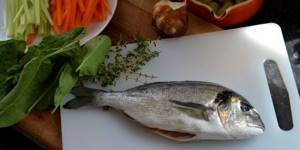
- If you are sure that the fish contains caviar, then you should not gut it. This fish is usually salted whole. But “empty” fish (without caviar) need to be cleaned of entrails.
- Another part that must be removed is the gills. They accumulate bacteria and harmful substances, like a cigarette filter. It is convenient to remove the gills with culinary scissors. By the way, the color of the gills can determine the degree of freshness of the fish.
Dry pickling
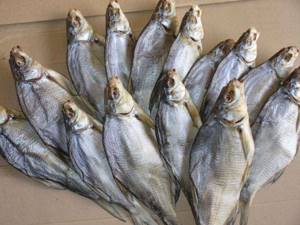
Salting bream using this method is very simple. Especially if you follow the step-by-step instructions.
- Prepare the carcasses in advance and rinse them in cool, preferably running water, before the salting procedure.
- Prepare salt at the rate of 250 - 260 g per 1 kg of fish.
- Rub each carcass with salt and place them tightly in a wooden box lined with linen or cotton cloth.
- Sprinkle each layer with a small amount of salt.
- Having laid out the last row, cover everything with the remaining salt and place the lid on top.
- Be sure to place pressure on it. It should be equal in weight to half the mass of the salted fish.
- With the help of a weight, the liquid will drain from the fish faster, and the bream’s meat will become elastic and denser.
- Under pressure, the fish should be kept in a cool place for 7 to 10 days. After that, it is taken out and soaked. This allows you to remove excess salt.
- After this it must be dried. To do this, it is suspended with a wire through the gill openings in a well-ventilated area or outside. The carcasses remain in this position for 14–16 days.
After proper salting, meat acquires a special taste, characteristic only of bream.
"Wet" or brine methods
You can properly salt bream for further drying or drying in brine. This will require prepared but uncut carcasses up to 30 cm.
To prepare, you will need an enamel bucket or other convenient-sized container, salt and purified water.
- Take the bream and put them in a container.
- Dilute the concentrated brine in a separate container. Potatoes or raw chicken eggs should not drown in it. You will need approximately 400 g of salt per 1 liter of water.
- Then fill the fish with brine and cover with a lid.
- Place a weight on top of it.
Many people do not know how long it takes for good salting. The fish should remain in this state for approximately 5–7 days, but if you introduce brine into the carcasses using a syringe, the time is reduced to 3–4 days.
After this, they must be taken out and rinsed well in running water. It is best to leave them under the tap for 60 – 90 minutes. This time will be enough to remove excess salt from the meat.
By the way, you can quickly salt pieces of fish using this method. In this case, the period of their presence in the brine is reduced to 1 – 2 days.
Bream can be salted in brine from its own juice (brine). For this you will need an enamel container and salt.
- Coat the carcasses very generously with salt.
- Place them in layers sprinkled with salt in a deep container.
- Cover with a lid and place pressure on top.
The fish should remain in this state for 8–10 days. Around the 2nd day, brine will begin to be released, and gradually it will fill the container. Mixed with salt, it will become brine.
After time, salted carcasses should be soaked a little in cool water. 24 hours and one water change will be enough. Using this method, it is best to salt bream for drying.
How to increase your fish catch?
Over 7 years of active fishing, I have found dozens of ways to improve the bite. Here are the most effective ones:
- Bite activator . This pheromone additive attracts fish most strongly in cold and warm water. Discussion of the bite activator “Hungry Fish”.
- Increased gear sensitivity. Read the appropriate manuals for your specific type of gear.
- Pheromone -based lures .
Each salting method is aimed at preparing a separate type of fish, although each recipe can actually be used for salting any fish and there will be no mistakes here. The main thing is to choose the right ratio of ingredients, depending on the size of the fish.
Everyone wants not to oversalt, although many experts say that it is better to oversalt it and then soak it in cold water for a certain time.
Most recipes are derived from some classic recipe by adding various additional ingredients. And here it is very important that these ingredients do not spoil the taste of the fish. As a rule, the following classic recipe is used for salting fish, based on 100 grams of product:
- Salt – 4 tbsp. spoons, which is about 90 grams.
- Sugar – 1 gram.
- Two carnations.
- 8 grams of pepper (any kind).
- You can add cinnamon, coriander and rosemary.
- Vodka – 90 grams.
Features of salting small fish
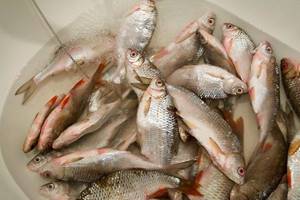
For salting, only special glassware or enamelware is used, or, in extreme cases, stainless steelware. Standard salting includes up to 1 kg of fish and 15 grams of salt. For stronger salting, take from 30 to 100 grams of salt. To keep the fish longer, up to 10% saltpeter is added to it, and you can use a wooden box for salting. In this case, the salt concentration should be higher. The salted product should be stored in a cool place, while fish such as sprat, sprat or anchovy are prepared without preliminary cutting.
Before the salting process, the fish is thoroughly washed in cold water, after which it is necessary to remove excess moisture from the glass. After this, it is mixed with salt, and this must be done so that the salt sticks to the entire surface of the fish, after which the fish is placed tightly in a special container prepared in advance.
After placing the fish, it is pressed down under pressure. That is, they take, for example, a wooden circle and place a stone on it. This is necessary so that all the fish can be cooked equally while in the brine. To salt fish in this way, take 1 kg of product, salt, different types of pepper, bay leaf and saltpeter. The fish is salted for 2-3 days. Alternatively, various spices are added to the product, in the form of currant leaves or regular blackberries.
Salting medium-sized fish

For regular but strong salting, you need to take up to 200 grams of salt per 1 kg of the original product. Before this process, the fish is well cleaned, with the entrails removed. At the same time, they use a method when the fish is cut not in the abdominal area, but along the back. After this, the fish is washed in cold but salty water. To do this, take 2-3 tablespoons of salt per 1 liter of cold water. The fish is washed until the water is clean and free of blood.
For salting you will need:
- 1 kg of medium-sized fish.
- 200 grams of salt per 1 liter of water.
- Bay leaf and pepper to taste.
- Cardamom or juniper, depending on the origin of the recipe.
- 1 tablespoon sugar.
- Ginger or nutmeg.
- Rosemary or cardamom (can be combined).
Medium-sized fish prepared using this method should be kept in a cold cellar. On the second day, the juice formed during the salting process is drained, and fresh brine is poured into place. Subsequently, the brine is replaced on the 4th and 6th days. The total cooking time for fish is about 10 days.
After 10 days, the fish is placed in jars and then closed with a tight lid. For storage, the product is placed in a dark, cool place, and before use, it is better to soak it in water for 1 hour.
Medium-sized fish is salted with both strong and medium salting, depending on the specific conditions and tastes of the person himself.
After 10 days of the salting process, the fish can be eaten.
Salting large fish

Cooking large fish requires gutting, and even better, if you cut it lengthwise and spread it out, then the quality of cooking will be the highest. In any case, the entrails are removed and the head is removed altogether. An incision is made along the back, and it is advisable to remove the spine and most of the bones. The meat should be wiped with a rag and rinsed with water and then immediately rubbed with salt.
IT IS IMPORTANT TO KNOW! Fishermen caught 25 kg of fish using the Fish XXL ! Read more.
Several types of salting of large fish are used:
As a rule, cooking large fish requires a lot of money and time. For regular salting, only coarse salt is used. It allows you to get the most delicious product, and will also allow you to quickly remove moisture from the fish. Coarse salt has the best preservative properties because it does not dissolve as quickly at low temperatures. Before salting, the fish is thoroughly washed and salted, but do not forget to salt the inside of the belly first.
The fish is placed in a specially prepared container with its belly up. A layer of salt is also placed between the fish. The larger the fish, the longer it will take to salt.
Salting fresh frozen fish
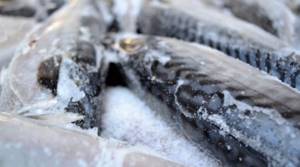
Since fresh fish is difficult to obtain, fresh frozen fish is salted and frozen on a fishing boat using the flash freezing method. Therefore, first of all, you need to defrost the fish and do everything correctly. The defrosting process should take place under natural conditions, without forcing this process. To do this, you can put it in the refrigerator overnight.
A group of fishermen revealed the name of the secret bait during interrogation.
Category: regional news.
Only high-quality original products need to be salted. Frozen fish should not have a layer of ice, and there should be no damage to its body. The eyes should be light and the sides should be round and thick. When pressed, the meat should be dense and elastic. If the recipe requires removing the skin, it is better to do this from frozen fish. Then the fish's head and tail are cut off, along with its fins. After this, it is gutted and washed thoroughly. It would be a good idea to remove all the bones with the spine. If the fish carcass is large, then it is better to cut it into pieces weighing 50 grams. After this, the onion is cut and laid on top, with the addition of garlic and spices.
Each piece is salted separately, and the fish is placed tightly in a container. The pieces are sprinkled on top with the same dry mixture, with onions and garlic, as well as seasonings. Finally, the fish is placed in the refrigerator. If you put this fish in the refrigerator in the evening, you can eat it in the morning. Carcasses weighing up to 1 kg can be salted whole. In this case, it is better to remove the head, tail and fins, and also gut it carefully.
Read also: Rose Falstaff photo and description
Recipes for salting herring
Herring in brine
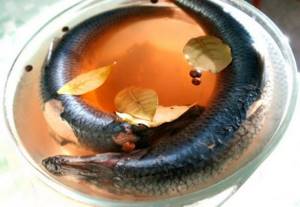
First of all, you should choose quality fish. It is better if it is freshly caught fish, but freshly frozen fish will also work. It is better to choose large and fatty herring carcasses, since after salting they will be the most delicious.
As a rule, the most delicious herring is considered to be Pacific or Atlantic herring, with silvery skin, clear eyes and fins pressed to the body. Such fish is usually salted in jars, placing the fish in them head down and filling it with brine. To prepare the brine, take 1 liter of water, 5 tablespoons of salt, 5 peas of black allspice, sugar and bay leaf.
How to salt a large bream whole
Large bream can also be salted using the brine method.
For this:
- first prepare a strong brine so that the raw egg does not sink in it (about 350 g per liter of water);
- then the brine is pumped into the syringe into the fish through the anus;
- put the carcasses in brine and take them out to a cool, dark place;
- after 2 days, the oppression is applied and left for 5 days; if the brine becomes cloudy, then it is removed and fresh is poured in;
- then washed for 2-3 hours and dried for a week or more.
- At the same time, measures are taken to eliminate flies.
Very large bream can be flattened, the entrails and heads removed, rubbed well with salt on both sides (300 g per 1 kg of bream) and placed flat or folded under pressure. After 3 days, soak the carcasses for 24 hours in changing water and send them to dry.
Drying bream
After the fish have been salted, they should be dried.

For this:
- carcasses or half-carcasses are cleaned with a brush or cloth from the remains of brine and mucus;
- hang it on a strong string and take it out into the draft for 4 hours or turn on the fan for 2 hours so that the bream dries well on the outside; with the second method, the air flow will prevent flies from appearing;
- The best time to prepare dried bream is autumn, when the process can be organized on the balcony at a suitable temperature.
On a note! Since air humidity increases at night, it is better to bring the fish indoors after sunset, and again put it on the balcony in the morning.
Fillet can be dried in fruit dryers. To do this, the carcasses need to be cut into fillets, salted under pressure, washed for 1 hour, wiped with napkins, cut into strips and dried on mode 1 for 10-11 hours. Caviar is also dried.
Salting fish for smoking
Salting begins with the selection and preparation of carcasses: individuals of the same size are left for hot smoking so that the cooking time is the same. Then the fish is gutted (if the size requires it), the gills and fins are removed and washed thoroughly. To make cooking go better, it is recommended to make small cuts on the backs. So, how to pickle bream for smoking:
- Soaking in a concentrated solution. It is prepared at the rate of 80 g of salt per 1 liter of water. The method is the simplest, since the fish is simply dipped into it and left for 6-10 hours.
- Rub the carcasses with salt. For 10 kg of product take 1.5 kg of salt. Each fish should be thoroughly rubbed on all sides (including the inside) and placed in rows in a container. Next, cover with a lid and place a weight on top. The fish will be salted in this way for up to 16 hours.
In both cases, after salting, the fish must be soaked in running water for 30-50 minutes and then dried a little. Large breams are cut into small pieces or dried with spacers in the belly. After the bream has been salted, you can start smoking the fish.
Cooking caviar
You can also salt the caviar along with the fish, and this way the dried or dried carcass will be much tastier. However, if the bream is large, then it is better to remove the eggs and cook them separately. Before salting bream caviar at home, you need to choose a method: simple (salting in bags) or more difficult (extracting eggs from film).
In the first case, you just need to remove the bags of caviar from the belly and wash them under running water. Next, pour a little salt into the container, lay the product in rows and sprinkle with salt, sometimes add ground pepper or other spices. Leave the dish to cook in a cool place for 24 hours, and then rinse and serve. In the second method, the natural film that covers the caviar should be removed. To do this, the bags are rolled through a meat grinder, rubbed through a sieve or colander, and it is also possible to remove the shell with a fork or knife. Afterwards, you need to rinse the eggs and let the excess liquid drain. When the product is crumbly and light in color, you can start salting. It is enough to sprinkle the caviar with a small amount of salt, mix and leave for a day, but sometimes the dish is ready in just a few hours.
At home, it is possible to wither bream, dry it or smoke it. The dish turns out delicious and can be stored for a long time. You definitely need to know how to properly salt bream so that the fish turns out to be of good quality. Proper preparation allows you to preserve all the beneficial properties for a long time.
You can ask your question to our author:
Quick salting
Method No. 1
- Boil the brine (1 liter of water + 40 g of salt) and immerse the carcass of cleaned, gutted and washed fish in it for a minute. Then dip it in vinegar diluted with water for a couple of minutes.
- Add another 100 g of salt to the brine, mix and place the fish in it for half an hour.
- Remove the fish from the brine and hang it in a draft under a canopy, on a balcony or loggia.
- When salt appears on the carcasses, this will mean that the fish is ready.
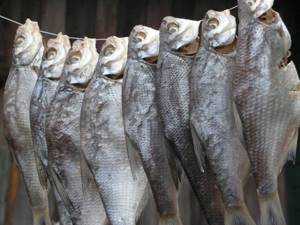
Bream marinated in a jar
Ingredients (per 0.75 l can):
- bream – 0.5 kg;
- onions – 0.2 kg;
- salt – 40 g;
- sugar – 60 g;
- refined vegetable oil - how much will be needed;
- seasonings for fish - to taste.
Cooking method:
- Wash the bream, clean it, gut it. Rinse again and dry with a kitchen towel.
- Sprinkle the pieces of fish with sugar and stir. Leave for 15-20 minutes.
- Shake off the sugar.
- After removing the husks, cut the bulbs into half rings and remember to provoke the release of juice.
- Sprinkle the fish with salt and spices and mix well. Place fish and onions in a 750 ml or quart jar, alternating.
- Pour vegetable oil over the food until it completely covers it.
- Close the jar with a plastic lid and put it in the refrigerator.
After three days, the snack will be ready to eat. It will be enough to transfer it to the herring bowl and serve it to the table.
